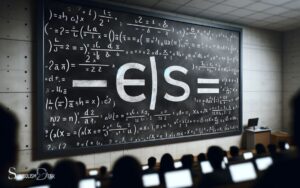Symbol for There Exists in Math: Explanations!
The symbol for “there exists” in mathematics is denoted by the existential quantifier, which is depicted as ∃. It is used to express that there is at least one element in a particular set that satisfies a given property.
The “there exists” symbol (∃) plays a crucial role in predicate logic and mathematical proofs. It is used to state that within a certain domain, there is at least one element for which a proposition or predicate holds true.
For instance, when mathematicians want to say that there is at least one number x that is greater than 2, they would write it as ∃x > 2.
The symbol is also often used in conjunction with universal quantifiers, variables, and various mathematical predicates to form more complex mathematical statements. These statements are fundamental in expressing properties, relationships, and operations across diverse areas of mathematics. For instance, the symbol for about in math, often represented by a tilde (~) or two stacked tildes (≈), is frequently used to denote approximation or near equality in equations and expressions. By combining such symbols with logical and quantitative structures, mathematicians can convey intricate ideas with precision and clarity.
Here’s a short example:
This statement asserts that in the set of natural numbers, there is at least one number that is both prime and even.
In mathematical discourse, the compact notation ∃ serves as a foundational concept, facilitating precise expressions of existence without the need for verbose explanations.

Key Takeaway
Origin and Meaning of
The symbol for ‘there exists’ in mathematics, denoted as ∃, originates from the existential quantifier in first-order logic and is used to assert the existence of at least one element in a set that satisfies a given condition.
In mathematical logic, the existential quantifier is fundamental for expressing statements about the existence of objects that satisfy certain properties.
It allows mathematicians to make assertions about specific elements within a set without having to explicitly define those elements.
For example, the statement ∃x (x > 5) asserts that there exists at least one element in a given set that is greater than 5.
This powerful symbol enables concise and precise articulation of the existence of solutions, objects, or elements meeting specified criteria within mathematical contexts.
Usage in Logical Quantification
Originating from first-order logic, the symbol for the existential quantifier, denoted as ∃, is used to express the existence of at least one element in a set satisfying a specified condition, playing a crucial role in logical quantification.
In logical quantification, the symbol ∃ is employed to assert that there exists an element within a given domain that satisfies a particular property or condition.
This is pivotal in formalizing statements and proofs in mathematics, computer science, and philosophy.
For instance, in the statement “∃x (x > 5)”, the symbol ∃ is used to assert that there exists at least one element in the domain of discourse that is greater than 5.
Such usage allows for precise and rigorous reasoning about the existence of objects that fulfill specific criteria within a given context.
Representation in Set Theory
In set theory, the existential quantifier ∃ is utilized to denote the existence of at least one element in a set that satisfies a specified condition.
This representation is fundamental in understanding the concept of existence within sets and is widely used in mathematical reasoning.
When considering representation in set theory, it is important to note the following:
- ∃x ∈ S: The symbol ∃x represents the existence of an element x in the set S.
- P(x): Denotes the condition that the element x must satisfy.
- ∃x ∈ S : P(x): The combined expression signifies the existence of at least one element x in set S that satisfies condition P(x).
- Use in set-builder notation: The existential quantifier is commonly used in set-builder notation to define sets based on specific properties.
Understanding the representation of the existential quantifier in set theory is crucial for its applications in predicate logic and mathematical proofs.
Applications in Predicate Logic
Applications in Predicate Logic When considering the existential quantifier in set theory, its applications in predicate logic are fundamental for formalizing statements about the existence of elements that satisfy specific conditions within mathematical reasoning.
In predicate logic, the existential quantifier (∃) allows the formulation of statements such as “there exists an x” or “for some x,” enabling the expression of properties that hold true for at least one element in the domain.
This is essential for defining properties, making assertions, and reasoning about the existence of objects that satisfy certain criteria within mathematical structures.
Predicate logic provides a rigorous framework for expressing and analyzing these existential statements, playing a crucial role in formalizing mathematical arguments and proofs.
Importance in Mathematical Statements
The importance of the existential quantifier in mathematical statements lies in its ability to formalize assertions about the existence of elements satisfying specific conditions within mathematical reasoning.
Its significance includes:
- Precision: The existential quantifier allows mathematicians to precisely state that there exists at least one element with a certain property, avoiding ambiguity in mathematical statements.
- Logical Reasoning: It plays a crucial role in logical reasoning by enabling the formulation of propositions that assert the existence of solutions to equations or the presence of certain objects within a mathematical context.
- Set Theory: In set theory, the existential quantifier is essential for defining subsets based on certain conditions, facilitating the rigorous development of mathematical structures.
- Proofs: It is frequently used in mathematical proofs to establish the existence of specific mathematical objects, providing a foundational tool for reasoning and argumentation.
Conclusion
The symbol for “there exists” in mathematics holds significant meaning and usage in logical quantification, set theory, and predicate logic.
It plays a crucial role in expressing mathematical statements and assertions, providing a concise and powerful representation of the existence of elements within a given context.
Its origins and applications showcase the importance of this symbol in the realm of mathematical reasoning and proof.






